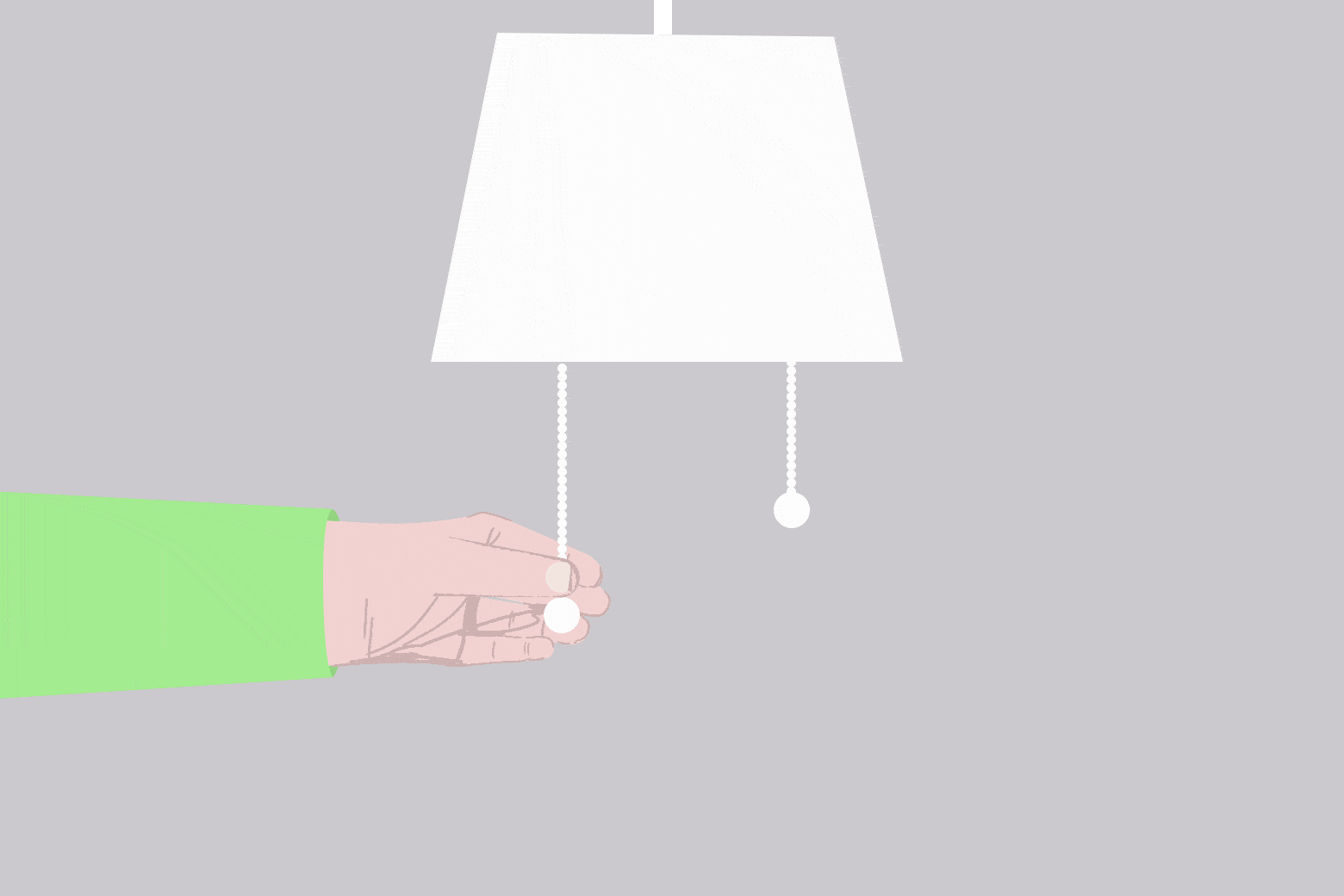Sign up for the Slatest to get the most insightful analysis, criticism, and advice out there, delivered to your inbox daily.
There is nothing in this world that my fiancée hates more than the raw, unvarnished lightbulb that hangs above the tiny foyer of our apartment. It is there to provide utilitarian white light for a closet and a washer/dryer combo, and to ensure that nobody will be fumbling around in the dimness while they look for their shoes or coat. But if it’s illuminated for any other purpose, under any other circumstances, she reacts like her eyes have been winched open, Clockwork Orange–style, in front of the blinding inferno of the sun. It is, perhaps, the one and only ground rule in our home. That light must remain dark, at all hours of the day, by any means possible.
You probably have a light like this in your living space. Maybe you call it “the overhead light,” or “the ceiling light,” but on the internet, aesthetes have begun to refer to it simply as “The Big Light.” The Big Light doesn’t mean to hurt anybody, but it’s become taboo among amateur interior designers. The trend began in earnest in 2022, when a hugely viral TikTok made by a user named GeeOfDee asserted that one of the ground rules in her household is that nobody—under any circumstances—is ever allowed to brighten the concave dome hovering above her living room. Her reasoning is that The Big Light immediately extinguishes the euphoric dimness of her domestic aesthetic, an assertion so relatable that it prompted discursive Big Light analyses in home-decor institutions like Apartment Therapy and Homes & Gardens. The discourse reached escape velocity shortly afterward—GeeOfDee’s video racked up 1.5 million views and has now blessed my own social circle with the language to articulate the precise contours of their preferred level of coziness. To them, heaven is a big couch, a fluffy blanket, and a faint swamp of amber-hued lamplight.
“I wasn’t always like this. I used to have my overhead lights on all the time. But I had a friend who was an interior designer, and she turned all of those off and repositioned my lamps. I thought it was condescending at first, but eventually I saw where she was coming from,” said Emily Johnson, who works in food media. Johnson’s conversion has been absolute. She has learned to despise The Big Light with so much invective that in her current apartment, she has placed a framed painting over its switch to ensure that the apartment shall remain darkened forever.
“I would go to people’s houses, or restaurants, and wonder why the vibe was off. And it was the light! The only problem is that the overhead light is on,” she continued. “It’s crazy how much you notice it. Conversation feels less meaningful when The Big Light is on. Everything feels less cozy and intentional.”
You will find a similar ineffability in everyone who abhors The Big Light. There is nothing specific they can point to for why it is so oppressive—it’s not like we’re sitting under a megawatt strobe, or a blaring red alarm—but there is a sense that white, room-filling brightness makes an environment much less snug and intimate, and is therefore better reserved for a school cafeteria than a home. Camilla Mikolajewska, who lives in Chicago and owns the curation company Vagabond Art, asserts that The Big Light ought to be deployed exclusively for matters of cleaning, cooking, and other chores. For everything else, though? Well, it is Mikolajewska’s belief that the world is more beautiful when we all see it a little less.
“I just started to notice a pattern in places with that kind of overhead lighting, compared to places that didn’t have that. I’ll get a migraine, or maybe I’ll just feel like I’m about to lose my marbles,” said Mikolajewska. “I think it has something to do with how our brains work. I multitask a lot, I have a lot of things going on, and a little thing like lighting can make me feel overstimulated.”
I suspect Mikolajewska is on to something there, and the science bears it out. According to research published by the University of North Carolina, cold lighting—as in, those spirit-breaking fluorescents threaded across office corridors—tends to make people more alert and productive (perhaps because it leaves them with a feeling of bureaucratic hopelessness), while low-color light temperatures, like the amber glow of candlelight, foster “relaxation and creative thinking”—ideal for a late-night dip into the ethereal realm. This is because exposure to bright light suppresses melatonin, the hormone that regulates our circadian rhythms. The pervasive white-blue sheen of phone screens is infamous in this regard, blocking melatonin secretion by more than twice as long as other colors, which is why some doctors recommend orange-hued glasses to help bedtime iPhone scrollers sleep.
Mikolajewska also argues that The Big Light, in its harshness, reveals things about your home you’d rather ignore. Like, say, the linty dust collecting on your bookshelves, or the blotchy patches of grease around the stovetop, subconsciously accumulating more errands to an already overcrowded plate. Lamplight isn’t strong enough to create such a daunting panorama, and perhaps that helps keep intrusive thoughts at bay. (It reminds me of how, as someone who wears glasses, I think it’s sometimes nice to take them off my face and savor a fuzzy collage of colors. There is freedom in indistinction!) Leah Alexander, an interior designer in Atlanta, holds this position as well. “Overly bright, concentrated sources of light feel like interrogation lamps or takeout-food heat lamps,” she said. “They don’t soften imperfections, in the space or its inhabitants. Typically, I feel like a vampire under attack when The Big Light’s switched on without warning.” Tough, but fair.
But Alexander claims that the debate over The Big Light doesn’t need to be a zero-sum game. For instance, The Big Light and “overhead lighting” are two different entities. “Small recessed lights are more manageable than one massive, harsh light source,” she said. “And dimmers on everything means justice for all lighting.” It’s true: With just a few dimmer switches, anyone can re-create the temperature they want in their home without necessitating a cavalcade of tiny lamps. Of course, actually installing the wiring for those dimmers requires some fairly adept electrical engineering, so you can understand why some folks end up simply putting a painting over the switch instead.
But here’s where I must confess that personally, I’m simply never going to be motivated to circumvent the harshness of my apartment’s lighting apparatus because, much to my fiancée’s chagrin, I think The Big Light is basically OK. In fact, I hardly ever notice whether it’s turned on or off, nor am I attuned to the subtle gradation of bulb warmth. Aahli Makhani, a 25-year-old logistics analyst in Atlanta, is aligned with my taste—and is perhaps the only verifiable Big Light stan on the internet. “I feel like the warm tones in light bulbs that most people prefer feel too stuffy. I sometimes feel a bit uncomfortable when the tone of a room is too warm and fuzzy,” he told me, adding that his lighting preference has sparked legitimate fights with his friends and family.
“They think I’m insane, but I can’t help that I like a bright white light,” he finished.
In fact, if Makhani wanted to be even more unsympathetic, he could argue that the fruitless attempt to optimize every vector of your personal comfort is a journey toward unhappiness, and while you molder away in eternal lamplight, other inefficiencies will slowly invade your mind. The lawn needs resodding, the living room should be a different shade, the whole house would be more picturesque if it were moved inches to the left. Yes, the attempt to precisely balance the smoldering heat of all those bulbs has only opened a mental portal to other shortcomings. But not me. I sit under the furnace of The Big Light, totally secure that nothing can ever be perfect.
But that might change someday. Maybe, like Johnson, I will uncover a latent interior design twitch later on in life, and be thrust into the wondrous lifestyle of West Elm catalogs and IKEA trips. Our foyer will be shrouded in eternal darkness. Then, and only then, will I finally see the light.

